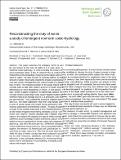Reconstructing the duty of water: a study of emergent norms in socio-hydrology
Author(s)
Wescoat, James
DownloadJ. L. Wescoat-2013-Reconstructing the d.pdf (105.5Kb)
PUBLISHER_CC
Publisher with Creative Commons License
Creative Commons Attribution
Terms of use
Metadata
Show full item recordAbstract
This paper assesses the changing norms of water use known as the duty of water. It is a case study in historical socio-hydrology, or more precisely the history of socio-hydrologic ideas, a line of research that is useful for interpreting and anticipating changing social values with respect to water. The duty of water is currently defined as the amount of water reasonably required to irrigate a substantial crop with careful management and without waste on a given tract of land. The historical section of the paper traces this concept back to late 18th century analysis of steam engine efficiencies for mine dewatering in Britain. A half-century later, British irrigation engineers fundamentally altered the concept of duty to plan large-scale canal irrigation systems in northern India at an average duty of 218 acres per cubic foot per second (cfs). They justified this extensive irrigation standard (i.e., low water application rate over large areas) with a suite of social values that linked famine prevention with revenue generation and territorial control. The duty of water concept in this context articulated a form of political power, as did related irrigation engineering concepts such as "command" and "regime". Several decades later irrigation engineers in the western US adapted the duty of water concept to a different socio-hydrologic system and norms, using it to establish minimum standards for private water rights appropriation (e.g., only 40 to 80 acres per cfs). While both concepts of duty addressed socio-economic values associated with irrigation, the western US linked duty with justifications for, and limits of, water ownership. The final sections show that while the duty of water concept has been eclipsed in practice by other measures, standards, and values of water use efficiency, it has continuing relevance for examining ethical duties and for anticipating, if not predicting, emerging social values with respect to water.
Date issued
2013-12Department
Massachusetts Institute of Technology. Department of ArchitectureJournal
Hydrology and Earth System Sciences
Publisher
Copernicus GmbH
Citation
Jr. Wescoat, J. L. “Reconstructing the Duty of Water: a Study of Emergent Norms in Socio-Hydrology.” Hydrol. Earth Syst. Sci. 17, no. 12 (December 3, 2013): 4759–4768.
Version: Final published version
ISSN
1607-7938
